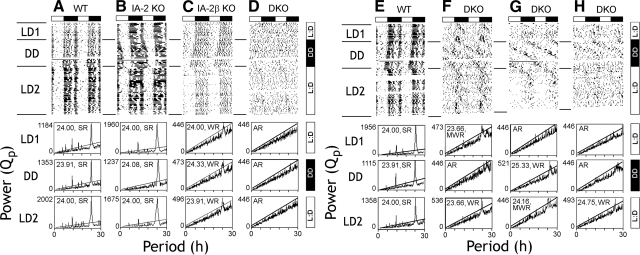Figure 3.
Wheel-running rhythms of WT, IA-2-KO, IA-2β-KO, and DKO mice. Double-plotted actograms (top panels) and χ2 periodograms (bottom panels) show activity under light-dark (LD1), constant dark (DD), and LD2 conditions. A, E) WT mice. B) IA-2 KO mouse. C) IA-2β KO mouse. D, F–H) IA-2/IA-2β DKO mice. Actograms depict wheel rotations double-plotted over 48 h. Rhythm strength (Qp) is shown on the ordinate and period on the abscissa of the periodograms. Peak Qp value for each panel is shown. Within each panel, period estimate and strength of rhythmicity are indicated. Components traversing the solid diagonal line in each panel are significant at P < 0.05 (χ2 periodogram). DKO mice express a variety of behavioral phenotypes, with some evidence of a weak rhythmic component when released back into LD (LD2). SR, strong rhythm; WR, single weak rhythm; MWR, multiple weak rhythms; AR, arrhythmic.

